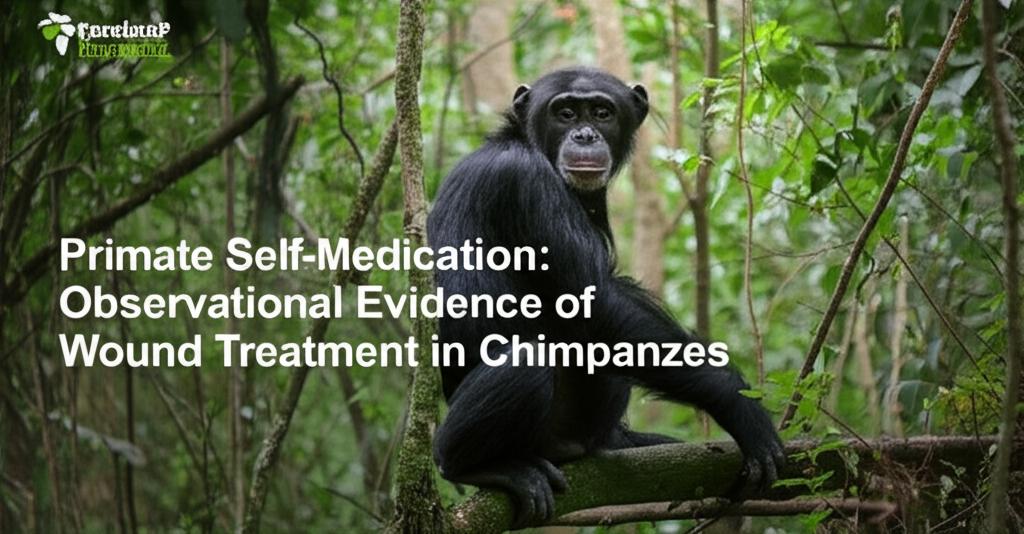The fascinating world of our closest living relatives, the chimpanzees, continues to offer profound insights, not only into their complex social lives and intelligence but also into the very origins of behaviors we often consider uniquely human. Among the most captivating of these is the growing evidence of primate self-medication, particularly the observed instances of wound treatment. This isn't just a matter of licking a scratch; it's a far more sophisticated and, at times, even altruistic set of behaviors that challenge our understanding of animal cognition and the evolutionary roots of healthcare.
Recent groundbreaking observations have illuminated the remarkable ways chimpanzees address injuries. Scientists have documented these primates in the wild, notably in places like the Budongo Forest in Uganda and Loango National Park in Gabon, engaging in deliberate actions to care for their wounds and even those of their companions. These behaviors are not isolated incidents but rather a developing field of study revealing a surprising depth of "forest first aid."
One of the most striking discoveries involves the topical application of chewed plant matter or insects to open wounds. Researchers have painstakingly recorded instances where chimpanzees select specific plants, chew them, and then meticulously dab the resulting poultice onto an injury. This isn't a random act. Pharmacological analysis of some of these plants has revealed that they possess antibacterial and anti-inflammatory properties, aligning with their use in traditional human medicine in the same regions. For example, dead wood from the Alstonia boonei tree, also used by local human communities for various ailments, has shown strong antibacterial and anti-inflammatory effects. Similarly, leaves from a fern (Christella parasitica) and bark and resin from the East African mahogany tree (Khaya anthotheca) have demonstrated potent anti-inflammatory properties.
The methods of wound care are diverse. Beyond applying chewed plants, chimpanzees have been seen directly licking wounds, which can help remove debris and may introduce antimicrobial compounds from their saliva. They also engage in finger licking followed by pressing on the wound, and leaf-dabbing. Each of these techniques suggests a level of intentionality aimed at cleaning and treating the injury.
Perhaps even more astounding is the observation of chimpanzees applying substances, specifically insects, to their wounds. In Loango National Park, researchers witnessed chimpanzees catching flying insects, apparently crushing or immobilizing them between their lips, and then rubbing them onto their own injuries. Over a 15-month period, this behavior was recorded numerous times. While the exact species of insects used and their precise medicinal properties are still under investigation, the targeted nature of this behavior strongly suggests a therapeutic purpose. Scientists are working with entomologists to identify the insects and understand their potential healing compounds.
What elevates these observations beyond simple self-preservation is the evidence of chimpanzees treating the wounds of others. This prosocial behavior, extending care to individuals beyond oneself, is a significant finding. Researchers have documented adult chimpanzees tending to the injuries of others, including unrelated individuals. For instance, a young female was observed dabbing chewed plant material onto an injury on her mother's body. In another case, an adult male dabbed a wound on another with a leaf from a plant also known by local people for its medicinal uses. There are even records of a male chimp sucking the wound of an unrelated male and another instance of a male freeing an unrelated female from a snare.
These acts of tending to others, especially those who are not close kin, hint at a capacity for empathy and altruistic behavior. It suggests that chimpanzees can recognize suffering or need in others and take deliberate actions to alleviate it, even when there's no immediate genetic advantage to doing so. This challenges the long-held notion that such complex empathetic responses are exclusive to humans.
The implications of these findings are far-reaching. Studying primate self-medication, a field known as zoopharmacognosy, offers a window into the evolutionary origins of medicine. It suggests that the foundations of human healthcare – recognizing injury, seeking out remedies, and caring for others – may have roots deep within our primate ancestry. If chimpanzees, our closest living relatives, exhibit these behaviors, it's plausible that our common ancestors also possessed rudimentary forms of medical knowledge.
Furthermore, the specific plants and insects used by chimpanzees could offer new avenues for pharmacological research. Indigenous human populations have long relied on natural remedies, and the observation of primates using similar resources reinforces the potential medicinal value of these species. By understanding what these animals are using and why, scientists might uncover novel compounds for human medicine.
The learning aspect of these behaviors is also a crucial area of ongoing research. It's not yet definitively clear whether these wound-tending practices are innate, learned through individual trial and error, or socially transmitted. However, observations of young chimpanzees watching adults treat their wounds, and in one case, a young chimp assisting its mother after observing her self-treatment, suggest that social learning likely plays a significant role. This would imply a form of cultural transmission of medical knowledge within chimpanzee communities.
The injuries that necessitate such care often stem from conflicts within or between groups, accidents, or unfortunately, human-set snares. The fact that some chimpanzee communities show high rates of snare-related injuries underscores the impact of human activities on these animals and highlights the adaptive importance of such self- and other-directed medical behaviors.
In conclusion, the observational evidence of wound treatment in chimpanzees is a vibrant and rapidly evolving field of research. From the careful selection and application of medicinal plants to the surprising use of insects and the poignant instances of altruistic care, these behaviors are reshaping our understanding of primate intelligence, social complexity, and the ancient origins of healing. As scientists continue to delve into the "forest pharmacy" and the sophisticated behaviors of our primate cousins, we stand to learn much more, not only about them but also about ourselves and the deep history of our own drive to heal and care for one another. The chimp doctor, it seems, has much to teach us.

